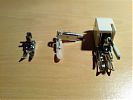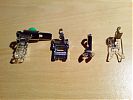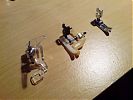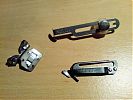I was planning on next sewing up a long-sleeved linen shirt for James using BurdaStyle’s Jakob pattern, but having read through Shirtmaking: Developing Skills for Fine Sewing by David Page Coffin, I soon realised that all my previously sewn shirts were terribly amateur and that I’d learned SO MUCH in just reading the first ten pages that I’d no longer be able to go back to my own ignorant ways after eating from the tree of knowledge.
One of the things Coffin said is absolutely necessary is a felling foot for your sewing machine, which I don’t have. These seem to be a rare item for non-Pfaff machines in the UK, so I’ve had to buy one off American eBay (along with a rolled hem foot from the same seller, which Coffin also recommends).
Before I bought the feet, I had a quick rifle through my sewing machine feet box first to see if I already had them and just didn’t know what they were. When I got my sewing machine from my sister-in-law, she threw in a little plastic box full of feet and spare bobbin casings and screwdrivers and all sort of random pieces that she thought went with the machine. Some I’ve been able to identify, but others are still a mystery, so I’m hoping some of you will be able to help me out…

The A Team – the feet I use all the time! From left to right: the standard foot, the adjustable zipper foot, and the walking foot

First Division – which only see occasional use. From left to right: the invisible zipper foot, the roller foot, the button foot, and the clear standard foot

The “I Might Use Them Someday?” Feet – From left to right: The darning/embroidery foot, the blind hem foot, and ??? (I have no idea – anyone know what this is for?)

Please Help Me Identify Pile – these are some bits that don’t look like feet but were included in the box. Does anyone have any idea what these parts do? I’d be very grateful, and who knows, I might have a fantastic gem hidden in here that could save me lots of time in the future!
So while I wait for the felling and rolled hem feet to arrive, I’m finally putting an old length of IKEA table runner fabric to good use, and making a quick Patrones skirt and a new shopping bag…
Attention old sewing machine owners! Krista is compiling a list of reviews of old sewing machines to help out beginning sewers who may find machines on eBay or freecycle or flea markets and not know whether it’s a good machine or not. I’ll be adding my retro beauty to the list, and you can add yours by emailing her using the link on the site.
Edit: Thank you to everyone who helped out! Read some of the conclusions and see an action photo here!
